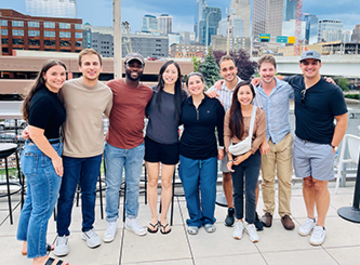
Interventional Radiology - Integrated Residency Program
Program Overview
Interventional radiology is a patient care-driven program with a strong clinical presence. Residents rotate through three University hospitals in Minneapolis, learning adult and pediatric interventions, taking call with a supervising faculty member, and managing patients from pre-procedural assessment through post-procedural follow up.
Each faculty member is subspecialized, providing residents with high-level training in a wide variety of vascular and non-vascular disease processes and interventions, including peripheral vascular disease, aortic endografts, venous disease, dialysis access, TIPS, BRTO, tumor embolization (including chemoembolization and radioembolization), tumor ablation, fibroid embolization, prostate embolization, vascular malformation embolization, vertebroplasty, biliary interventions, genitourinary interventions, vascular access, biopsies and drain placements.
We perform a high volume of non-invasive vascular imaging as well, so residents also learn to read CTAs, MRAs and vascular ultrasounds.
See our Diagnostic Radiology Residency page for info on ESIR designation.
Contact
IR Integrated Residency Program Director
Reza Talaie, MD
rtalaie@umn.edu
IR Integrated Residency Associate Program Director
Prashant Shrestha, MD
pshresth@umn.edu
GME Program Administrator
Breckyn Avery
avery203@umn.edu
612-625-6916
Application
A complete application via ERAS must include:
- Three letters of recommendation
- Dean's letter
- Personal statement
- Curriculum vitae
- Official medical school transcript(s)
- USMLE (Step I and Step II, if available) or COMLEX scores
- Photograph
Medical students who wish to apply to both the IR/DR Residency and the DR Residency at the University of Minnesota are welcome to apply for both. Applications for the IR/DR residency and the DR residency are reviewed and considered separately.
Application deadline November 1.
Eligibility
To be eligible for appointment, the clinical-base candidate must be:
- A student in good standing at an American or Canadian medical school approved by the Council of Medical Education of the American Medical Association.
- A rotating or straight internship approved by the ACGME (Accreditation Council for Graduate Medical Education) also meets admission requirements and may be used to satisfy the PGY-1 requirement.
- Graduates of foreign medical schools must hold an ECFMG or FLEX certificate or possess a license to practice medicine in the United States.
- A Minnesota medical license is not required for appointment, but each resident should make the necessary arrangements early in their CA-3 year if they anticipate remaining in Minnesota.
- Applicants with a foreign medical degree should check with the Educational Commission for Foreign Medical Graduates (ECFMG) for information.


